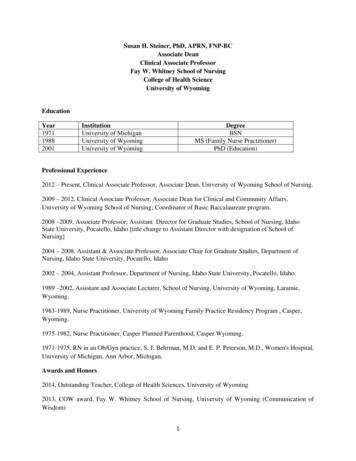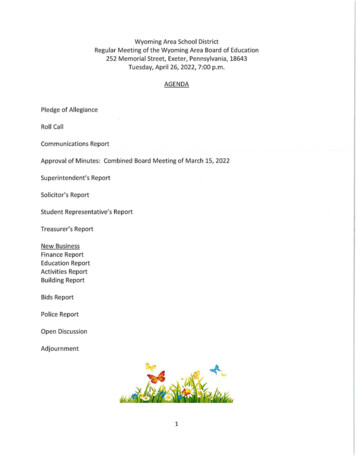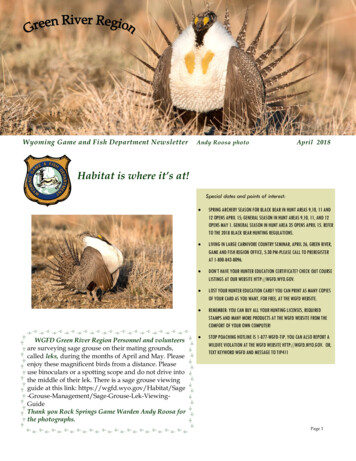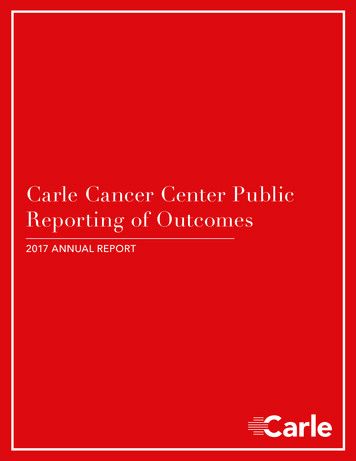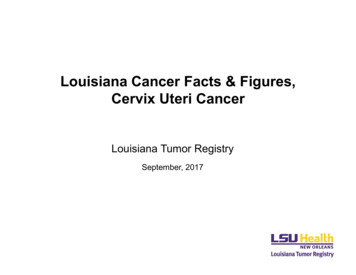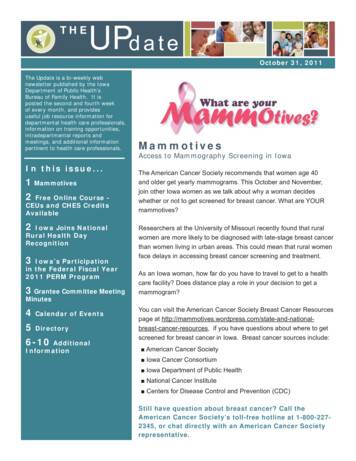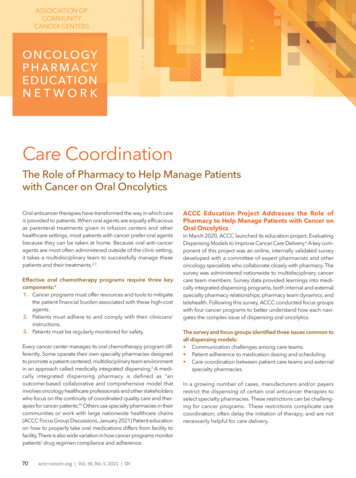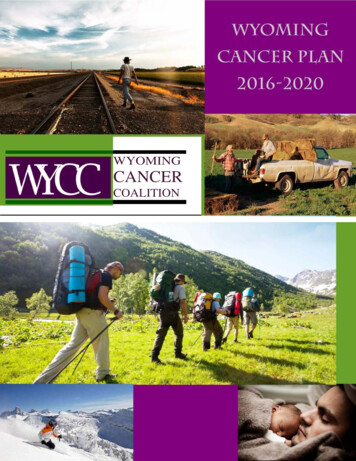
Transcription
WYOMINGCANCERCOALITION
2
Wyoming Cancer Control Plan2016-2020Published February, 2016Matthew H. Mead, GovernorThomas O. ForslundDirector, Wyoming Department of HealthFor more information regarding the Wyoming Cancer Coalition (previously known as the WyomingComprehensive Cancer Control Consortium) and the Wyoming Cancer Control Plan, please contact:Wyoming Integrated Cancer Services ProgramComprehensive Cancer ControlWyoming Department of Health6101 Yellowstone Road, Suite 510Cheyenne, Wyoming 82002307-777-8609www.fightcancerwy.comThis publication was supported by Cooperative Agreement Grant # 5U58DP003896-03 from theCenters for Disease Control and Prevention. Its contents are solely the responsibility of the authorsand do not necessarily represent the official views of the Centers for Disease Control and Prevention.3
MATTHEW H. MEADGOVERNORTHE STATESTATE CAPITOLCHEYENNE, WY 82002Office of the GovernorI am pleased to present Wyoming's Cancer Control Plan for 2016-2020 and thank the WyomingComprehensive Cancer Control Conso11ium (WCCCC) for preparing it. To create this plan forthe future, the WCCCC looks to the work done under the past plan and recommends changes infocus and direction to address the burden of cancer in Wyoming and lessen its impact.All individuals , all families, are touched some way, somehow, some time in their lives, bycancer. Whether it is a parent, a si bl ing, a child, a friend, a work colleague - everyone is affected.None of us are strangers to this disease , and we greatly appreciate the efforts of the WCCCC to planstrategically to reduce its reach and effects.This plan is comprehensive. It provides our state with a complete program that outlines goals ,objectives and strategies for prevention , early detection, diagnosis and treatment, quality of life,childhood cancer and advocacy. It provides a call to action for everyone to be involved. We canall do our part by helping ourselves and by helping others - for example , with healthier lifestyles,getting screened, supportive care and volunteering.The work of many hands , not just a few is vital to lessening the impact of cancer in Wyoming. Ithank the chairpersons of the WCCCC for their leadership. I thank the individuals andsponsoring organizations who have dedicated time and expertise to developing this plan. I thankall Wyomingites for joining the fight against cancer. Together, we can make a difference!Matthew H. MeadGovernor
The Wyoming Cancer Control Plan aims to reduce the cancer burden in Wyoming and improve the livesof all Wyoming residents. The overall success of the plan will depend on the cooperation,collaboration, and resources of many stakeholders across the state.Below are a few examples of what you can do to help work toward the goals presented in the CancerControl Plan. Use these examples, and think of other actions you can take to reduce the burden ofcancer in your community and throughout Wyoming.If you are a hospital: Ensure that your cancer cases are reported in a timely manner. Collaborate to sponsor navigation and survivorship programs. Collaborate to sponsor community screening and education programs. Seek or maintain accreditation through American College of Surgeons, TheJoint Commission, etc. Implement tobacco-free policies at your facility.If you are a local health department: Support policy, environmental, and systems changes for cancer control. Provide cancer prevention awareness information and screening programs. Provide navigation services for clients. Collaborate in community prevention campaigns. Work with health care providers to promote screening programs and case reporting. Encourage participation in clinical trials.If you are a community-based organization: Support policy, environmental, and systems changes for cancer control. Implement tobacco-free policies at your facility. Collaborate with local health departments or hospitals to host screeningevents. Provide navigation services for clients. Collaborate to provide community prevention programs.If you are an employer: Seek or maintain CEO Cancer Gold Standard accreditation. Implement tobacco-free policies and provide access to healthy foods. Encourage employees to increase physical activity. Collaborate with local health care providers to host screening events. Use reminders and incentive programs (e.g., paid time off for screenings,screenings in the workplace) to reduce barriers to screening.5
If you are a school/university: Include cancer prevention messages in health classes. Provide healthy foods in vending machines and cafeterias. Increase physical education requirements. Collaborate with local health departments or hospitals to host screening events. Make your entire campus a tobacco-free environment.If you are a faith- based organization: Provide cancer prevention information to members. Learn how to provide healthy potlucks and meeting meals. Provide space for physical activity programs. Collaborate with local health departments or hospitals to host screening events. Encourage members to get cancer screening tests on time.If you are a health care provider: Provide culturally relevant counseling, information, and referrals for cancerscreening tests. Adhere to guidelines and best practices for prevention, treatment, andsupportive care. Refer patients to smoking cessation, physical activity, and nutrition programs. Be sure your cancer cases are reported in a timely manner. Find out how to enroll patients in clinical trials. Make appropriate referrals to hospice for end-of-life care.If you are a Wyoming Resident: Stop using tobacco products or never start. Eat more fruits and vegetables and maintain a healthy weight. Increase your daily physical activity. Know when to be screened and do it on schedule. Support comprehensive tobacco-free environment policies. If diagnosed, consider enrolling in a clinical trial. Show your support and care for those who are diagnosed. Volunteer with your hospital.6
*Sections containing the 2016-2020 Cancer Control Plan Goals, Objectives, and Action Items7
The Centers for Disease Control and Prevention (CDC) defines Comprehensive Cancer Control as “a collaborativeprocess through which a community pools resources to reduce the burden of cancer that results in risk reduction,early detection, better treatment, and enhanced survivorship.” Wyoming is dedicated to this approach andbelieves that this is the best way to successfully eliminate cancer. The CDC created the National ComprehensiveCancer Control Program (NCCCP) to help states, tribes, and territories form coalitions to conduct comprehensivecancer control. Wyoming received funding from the CDC in 2004 to establish Wyoming’s Comprehensive CancerControl Program and the Wyoming Comprehensive Cancer Control Consortium, which is now known as theWyoming Cancer Coalition (WYCC).Wyoming’s Cancer Control Plan 2016–2020 (the Plan) is a strategic plan to reduce the cancer burden in our state.It is designed to provide guidance to individuals and organizations spanning a wide range of health and socialdisciplines that can play a role in controlling cancer. All aspects of the cancer continuum are addressed including:primary prevention, early detection and screening, treatment, quality of life and end-of-life care, as well as crosscutting issues such as: advocacy, eliminating disparities, research, and surveillance. Wyoming’s plan has beenrevised with updated goals and measurable objectives to support continued cancer control efforts through 2020.This Plan builds on the hard work and collaborations that have made comprehensive cancer control a success inWyoming.Wyoming’s Comprehensive Cancer Control (CCC) Services follows the national model developed in 1998 as anintegrated and coordinated approach to cancer control. This table outlines some of the group’s major milestones:DateJuly 2004September 2004October 2005March 2007July 2007June 2009July 2009January 2010August 2012October 2012January 2016Significant EventReceipt of CDC NCCCP Cooperative Agreement award.Creation of the Wyoming Comprehensive Cancer Control Consortium.Published Wyoming Cancer Control Plan 2006-2010.Wyoming Cancer Control Act signed into law by Governor Dave Freudenthal. Thislegislation provided 1.6 million for enhanced cancer screening efforts and laid thefoundation for future efforts in comprehensive cancer control.Implementation of the County Cancer Resource Centers ProgramWyoming Comprehensive Cancer Control Consortium awarded the C-Change 2009Exemplary State Comprehensive Cancer Control Implementation Award.Wyoming House Representative Ken Esquibel, WYCC Co-Chair, was awarded the 2009Exemplary State Elected Official Comprehensive Cancer Control Leadership Award.County Cancer Resource Centers were renamed to Wyoming Cancer Resource Services and“regionalized” around the existing county locations to provide cancer resource servicesstatewide.Published Wyoming Cancer Control Plan 2010-2015.Camp Courage Wyoming was implemented and successfully held its first year of camp.Keith Howard was awarded the C-Change 2012 Exemplary Cancer Coalition MemberAward.The Wyoming Comprehensive Cancer Control Consortium was renamed the WyomingCancer Coalition. The 2016-2020 Wyoming Cancer Control Plan is published.Table 1 History of Wyoming's Comprehensive Cancer Control8
The Wyoming Cancer Coalition (WYCC) is a group of over 300Wyoming residents and supporters working together to promoteand implement the Wyoming Cancer Control Plan by coordinatingefforts throughout the state. The Coalition focuses on reducingcancer disparities, increasing awareness of the cancer burden inthe state, and improving outcomes for cancer patients. Coalitionmembers are: policy makers, advocates, individuals, businesses,cancer survivors, caregivers, family members, health careproviders, hospitals, insurers, non-profit and volunteerorganizations, the public health community, state and localgovernment, and others committed to cancer prevention andcontrol.www.fightcancerwy.comI am a wife, a mother, and a Cancer Survivor. At the age of 42,five months after my annual mammogram, I found a small lumpunderneath my right breast. I made an appointment with myphysician who, not being concerned, told me to watch it for a monthand if it was still there to make an appointment for an ultrasound.I wasn’t worried as I have no family history. Luckily I followed upand on September 17, 2013 at 1:50 p.m. in the afternoon (yes, Iremember the exact moment) I was diagnosed with an extremelyaggressive and fast growing type of breast cancer. Two years later,after numerous surgeries and chemotherapy, I am alive and I amCancer Free. I feel very strongly that my persistence and acting as myown advocate saved my life. If not for the wonderful people who preach aboutearly detection, screenings and what to do if something does not feel right, I might not be heretoday. I was also fortunate to have care givers who understand the toll that cancer can have onyour psyche and suggested I apply for the Wyoming Casting for Recovery retreat. During thesummer of 2014, I was one of 14 lucky ladies to experience this life changing weekend long event.I still smile every time I think of my “sisters,” the “Ladies in Waders!”9
Wyoming covers more than 97,000square miles, making it the tenthlargest state in the US, whileconcurrently being one of the nation’sleast populated states, with only584,153 persons claiming residency, [1]giving it an average of 5.8 people persquare mile. [2] Of Wyoming’s 23counties, 17 are designated as“frontier” and four counties aredesignated as “rural,” with 47 percentof Wyoming’s population living infrontier designated areas.According to the US Census Bureau,84.1 percent of the state’s population iswhite only (not Hispanic or Latino), 9.8percent of the population claimHispanic/Latino heritage, 2.7 percent isWyoming comes from the Dakota Indian word “wscheweamiing” meaning “at the bigflats” or “large plains.” Wide-open grasslands, scenic rivers, and spectacular mountainsAmerican Indian, 1.6 percent Africandominate the Wyoming landscape from the Grand Teton to Yellowstone National Park,American/Black, with the remaining 1.8from the Shoshone National Forest to the eastern Great Plains.percent identified as other or mixedrace. [3] Because of the low racial/ethnicdiversity in Wyoming, the disparities that are most often identified relative to cancer diagnoses and outcomes areassociated with socio-economic and access issues more so than race/ethnicity. Wyoming’s unemployment rate of4.3 percent is lower than the national rate of 6.2percent, and the median household income is 58,752.00. [4] Wyoming’s median age is 36, with23.6 percent of the population being under 18 years1.60%2.70%of age and 13.5 percent of the population being 65 or1.80%older. [5]Racial Diversity in Wyoming9.80%White OnlyHispanic/Latino84.10%AmericanIndian/Alaskan NativeAfrican American/BlackOther/Mixed raceChart 1 Racial Diversity in Wyoming10There are 26 hospitals in Wyoming, 23 of which arelocated in rural or frontier areas. [6] The state has 16hospitals designated as Critical Access Hospitals, [7] 16Rural Health Clinics, [8] 5 Federally Qualified HealthCenters that provide services at 13 sites statewide, [9]and 2 Veterans Affairs Medical Centers. [10]
The term “Frontier” is used to describe the mostremote and sparsely populated places, withresidents far from healthcare, schools, grocerystores, and other necessities. It is often defined ashaving a population density of six or fewer peopleper square mile.Communities in frontier areas face additionalchallenges in accessing healthcare and necessaryservices, even greater than those faced by other ruralcommunities. The isolation and distances that classifyan area as frontier result in long trips to attend school,shop for groceries, visit health care providers, andreach other basic services. Public transportationoptions are often limited or unavailable, makingaccess to needed services even more difficult for lowincome households, the elderly, and people withdisabilities.In Wyoming, many of these frontier areas faceseasonal travel barriers that make it difficult orimpossible to access services during the wintermonths. Some Wyoming roads close for the season,while others become obstructed by blowing snow and ice, leading to longer travel times for thosewho are willing to risk the drive. These barriers to travel can be particularly problematic when itcomes to emergency transportation, but can also lead to increased risks for people seeking routineexams, ongoing care for chronic conditions, and other necessary services. [11]In many frontier areas there is not only limited access to health care, but often there is also a shortageof health care professionals and specialists. Of the state’s 23 counties, 22 have some form of primaryhealth care professional shortages and 14 counties have at least one medically underserved area ormedically underserved population designation. [12] To further compound the problem, low populationin these areas makes it difficult to provide competitive wages and amenities that are often offered tophysicians and nurses in larger metropolitan areas. [13]For instance, there are currently nine practicing gastrointestinal specialists in the state, all of whomreside in Laramie county or Natrona county (the two areas of the state that are not designated asfrontier or rural). Although some of these healthcare professionals provide outreach in other parts ofthe state, the lack of permanent specialists proves to be a significant barrier to care and appropriatescreening.Frontier communities that have hospitals may experience higher costs for care due to the lowervolume of patients served. Some areas must cope with seasonal variations in healthcare needs, suchas population surges with tourists and seasonal workers. The limited health resources available areoften needed to care for the increased population, further restricting resources available for localresidents. [11]In 2014, approximately 10 percent of the residential population in Wyoming was not covered byhealth insurance, a decrease from the previous year’s 16 percent. In Wyoming’s Private Sector, 61percent of employers offered health insurance, an increase from 53 percent in 2013. Estimates from2013 indicate a poverty rate of 11.2 percent in rural Wyoming, compared to 10.2 percent in moreurban areas of the state, which is lower than the national rate of 14.5 percent. [14]11
A health disparity is best described as a type of health difference that is closely linked with social,economic, and/or environmental disadvantage. Health disparities adversely affect groups of peoplewho have regularly experienced obstacles to health based on a characteristics historically linked todiscrimination or exclusion, for example race or ethnicity, religion, socioeconomic status, gender,sexual orientation, age, mental health, or disability.Wyoming is one of the least racially diverse states in the United States, reporting 84.1 percent of thepopulation as white only, higher than the national average of 63.7 percent. The American Indianpopulation in Wyoming is also higher than the nationalaverage at 2.7 percent (national average is 1.2percent). [1]On the Wind River Indian Reservation, there areseveral healthcare resources available to tribalmembers. There are two outpatient clinics, andnearby hospitals in Lander and Riverton. Theoutpatient clinics are staffed with multiple healthcareprofessionals, providing specialized and primary careto their clients. The clinics also host a number ofspecialty programs such as orthopedic, podiatry,obstetrics, audiology, women’s health, nephrology,and cardiopulmonary services. [15]The Wind River Indian Reservation located insouthwestern Wyoming near Lander, is the thirdlargest reservation in the US, with an area ofabout 3,500 square miles. It is home to over3,900 Eastern Shoshone and 8,600 NorthernArapahoe tribal members.A review of surveillance data from the WyomingCancer Surveillance Program shows that cancerincidence rates are not significantly disparate among racial/ethnic minorities in Wyoming. In fact,incidence of some cancer types are significantly lower in Wyoming’s minorities than among the whitepopulation. While rates among minorities are higher in some cases, they are not statistically differentfrom the white population rate.419.1 / 100,000252.6 / 100,000*157.2 / 100,000*196.7 / 100,000*111.5 / 100,00054.0 / 100,000*37.2 / 100,000*55.1 / 100,000*37.6 / 100,00038.3 / 100,00019.4 / 100,000*33.9 / 100,00048.2 / 100,00016.3 / 100,000*No Cases25.2 / 100,000*117.9 / 100,00042.5/ 100,000*42.0 / 100,000**Significantly lower than the white population rate.Table 2 Cancer Incidence Rates 2009-2016 by Race12
In spite of lower cancer incidence rates, the minority populations of Wyoming face unique challengesrelated to health care services. High insurance rates, an average income of less than median, andmore single-parent households, coupled with limited local access to specialized health care providerscan make receiving appropriate screening and care difficult.Wyoming Median Family Income by Race:2010-2014 58,292 55,489 36,479 43,125 41,502MEDIAN FAMILY INCOMEWhite OnlyAfrican American / BlackAmerican IndianHispanic (any race)Other or Multiple RaceChart 2 Wyoming Median Family Income by Race 2010-2014Wyoming’s minorities have significant cancer risk factors. The Wyoming Behavioral Risk FactorSurveillance System (BRFSS) collects data specific to five cancer risk factors: current tobacco use being overweight (Body Mass Index greater than 25) not meeting recommendations for physical activity (150 minutes of moderate to vigorousphysical activity per week) heavy drinking (men: 60 or more drinks in the last month; women: 30 or more drinks in thelast month) eating fruits and vegetables less than five times per dayAlmost half of the non-white population in Wyoming has three or more of these five risk factors. [16]Incorporated throughout the 2016-2020 Cancer Plan, you will find objectives and action steps aimedat reducing the barriers and effects of the unique challenges identified in this section, as well asmeasures focused on improved access to appropriate healthcare, advocacy for policy, systems, andenvironmental (PSE) changes to support healthier living choices and reduce risk for all residents ofWyoming.13
Research suggests that only 5 to 10 percent of cancersare hereditary. [17] That means the non-inherited causesof cancer - lifestyle choices, the foods we eat, andphysical activity levels – have a direct impact on overallcancer risk. If preventing cancer was as simple as eatinga certain food or doing a certain exercise, this would bea much shorter conversation.Rural communities are at higher risk for substanceabuse, suicide, motor vehicle fatalities, obesity, cigarettesmoking, and death from unintentional injury. [11]This much is clear: You have a higher risk of developing cancer if you are overweight. Staying at a healthybody weight reduces your risk of cancer. Eating well – lots of veggies, fruit, and fiber, and little fat and sugar – will help preventcancer and keep a healthy body weight. Regular physical activity helps protect against cancer and is another great way tomaintain a healthy body weight, which reduces your risk of cancer. Eating processed meat increases your risk of cancer. Alcohol consumption increases your risk for multiple chronic problems, including cancer. Smoking cigarettes or using smokeless tobacco products increases your risk fordeveloping cancer (this is discussed in greater detail in the prevention section of this plan). [18]About one-third of all cancers can be prevented by eating well, being active, and maintaining a healthybody weight. You can lower your risk for cancer if you move more, stay lean, and eat plenty ofvegetables and fruit, as well as other plant foods such as whole grains and beans.People who are overweight or obese are at greater risk for many cancers, including breast, colon andrectum, esophagus, kidney, pancreas and uterus. Including at least 150 minutes of moderate activityeach week can make a difference.According to the National Cancer Institute, over fiftystudies have found that increasing physical activitycan reduce your risk of colorectal cancer by 30 to 40percent. Sixty studies on physical activity and breastcancer have also shown risk reductions between 20and 80 percent. About 20 other studies have shownthat increasing physical activity can reduce awoman's risk of endometrial cancer by 20 to 40percent. While not as well studied, there is someevidence that shows that physical activity can alsoreduce a person's risk of lung cancer and prostatecancer. [19]Physical activity is also one of the best ways to get toand maintain a healthy weight.14
While there is no one single food that you can eat to prevent or fight cancer, a balanced diet filledwith vegetables, fruits, soy, nuts, whole grains, and beans may help lower your risk for many typesof cancer.Adding “cancer protective foods” to one’s diet helps decrease cancer risk. Cancer protective foodsare low in calorie density (high in fiber and low in fats and sugars). Examples of “cancer protectivefoods” include whole grains, broccoli, carrots, leafy greens, green tea, grapes, berries, cherries, soyproducts, cauliflower, and apricots. These plant-based foods are high in nutrients that boost yourimmune system. Fruits and vegetablesare a great source of antioxidants such asbeta-carotene, Vitamin C, Vitamin D, andselenium. These powerful vitamins helpthe cells in your body function properly.The less processed these foods are, thebetter.Limiting consumption of foods thatincrease risk (such as red meats) andavoiding processed meats (bologna,bacon, ham, hot dogs) can furtherdecrease cancer risk. [20]There is increasing evidence to suggest that alcohol intake affects a person’s risk for cancer,specifically of the mouth, pharynx, larynx and esophagus, breast, colon, rectal, and liver. Even smallamounts of alcohol can increase your risk for certain cancers. [21]Heavier drinking raises the risk for many chronic problems, including cancer, heart disease, highblood pressure, stroke, osteoporosis, inflammation of the pancreas, damage to the brain, livercirrhosis, accidents, violence and suicide. Alcohol can also cause birth defects. If you are pregnantor may become pregnant, do not drink any alcohol. A woman’s risk for breast cancer increases withgreater alcohol consumption. Women at high risk for breast cancer should consider not drinking. [22]We encourage the people of Wyoming to take charge of their health by making healthier lifestyle, fitness and nutrition choices, and visiting with their health care provider regularly about:o Age-appropriate screeningso Fitness and nutritiono Any physical changes or health concerns15
DefinitionsA comprehensive declaration of purpose used to guide planning, and to identify theeventual desired outcome of the objectives and action steps documented within thisplan. These are few in number and emphasize the highest priorities throughout thecancer control continuum.A time-oriented and measurable statement that provides a specific focus in support ofa goal. Objectives have quantifiable milestones which include baseline data and targetswhere possible.Action oriented strategies and evidence-based (where possible) activities that have thepotential to significantly and positively impact the outcome of the documentedobjectives, thereby supporting the goals of the plan. The action steps listed in this plando not comprise a complete list of all possible strategic actions. Rather they act asexamples of recognized approaches that may be used to affect an outcome.16
Prevent cancer from occurringDetect cancer at its earliest stagesDiagnose and Treat all patientsusing the most effective and quality careEnhance survivorship and quality oflife for every person affected by cancerProvide the highest quality of cancercare and support for childhood cancerpatients and their families17
In 2015, an estimated 589,430 Americans were expected to die of cancer. This is almost 1,600 peoplea day. Cancer is the second most common cause of death in the United States and accounts for nearlyone of every four deaths. [23] In 2014, cancer accounted for approximately 990 deaths in Wyoming.[24]Cancer prevention is action taken to lower a person’s risk of getting cancer. In 2015, approximately1.6 million people were diagnosed with cancer in the United States. [23] The goal of prevention is tokeep cancer from developing through healthy lifestyle choices and avoiding contact with knowncancer-causing substances. It is not possible to know exactly why one person develops cancer andanother does not, but there are ways to reduce the potential for certain cancers to develop over aperson’s lifetime. By avoiding certain behaviors, taking action to improve your health, and preventingexposure to cancer-causing situations and substances, a person can reduce his or her risk for morethan 15 kinds of cancer.TobaccoIn the United States, tobacco use accounts for nearly one in five deaths, roughly 480,000 a year. It isresponsible for 87 percent of lung cancer deaths in men and 70 percent in women. Smokelesstobacco products should not be considered a safe substitute for tobacco cessation. These productscan cause oral and pancreatic cancers, precancerous lesions of the mouth, gum recession, bone lossaround the teeth and tooth staining. Tobacco use is linked with increased risk of more than 15 typesof cancer including: mouth, lips, nose and sinuses, larynx (voice box), pharynx (throat), esophagus(swallowing tube), stomach, pancreas, kidney, bladder, uterus, cervix, colon/rectum, ovary(mucinous), and acute myeloid leukemia.Exposure to secondhand smoke significantly increases a non-smoker’s risk of developing lung andother cancers in addition to other health problems such as decreased respiratory function and otherrespiratory diseases, eye and nasal irritation, heart disease and stroke. Pregnant women and childrenare particularly vulnerable to the health risks of exposure to secondhand smoke. [25]Based on data from the Wyoming Cancer Registry, in 2014 there were 254 cases and 226 deathsattributed to lung cancer. Wyoming Cancer Registry data also showed 112 cases of esophageal,laryngeal, nasal and oral cancers diagnosed in 2014 in Wyoming residents with 42 deaths attributedto cancers of the nasal, throat and oral cavities.RadonRadon is a colorless, odorless radioactive soil gas that comes from the decay (breakdown) ofradioactive elements found in the earth’s crust. It is inert, meaning that it is drawn by pressuredifferentials in the ground, and can be drawn into the air and water sources. Radon can build up inenclosed spaces, such as homes and basements, and if breathed over a prolonged period can causedamage to cells in the lungs. The EPA estimates that approximately 22,000 people die each year fromradon-induced lung cancer, and that between 10 and 14 percent of all lung cancers can be attributedto radon exposure. The only way to know if there are high levels of radon in a home is to test for it.[26]According to the 2010 Wyoming BRFSS, only 33.1 percent of Wyoming adults reported that theirhome had been tested for radon. [16]18
Radon levels can be reduced by: improving the ventilation in the home, avoiding the passage of radonfrom the basement into living rooms, increasing under-floor ventilation, sealing floors and walls,installing a positive pressurization or ventilation system, or installing a radon sump system in thebasement.Skin Cancer PreventionIn 2013, there were 125 new melanoma cases identified in Wyoming, and 15 deaths attributed to thisform of skin cancer. [24] Melanoma accounts for less than
believes that this is the best way to successfully eliminate cancer. The CDC created the National Comprehensive Cancer Control Program (NCCCP) to help states, tribes, and territories form coalitions to conduct comprehensive cancer control. Wyoming received funding from the CDC in 2004 to establish Wyoming's Comprehensive Cancer
